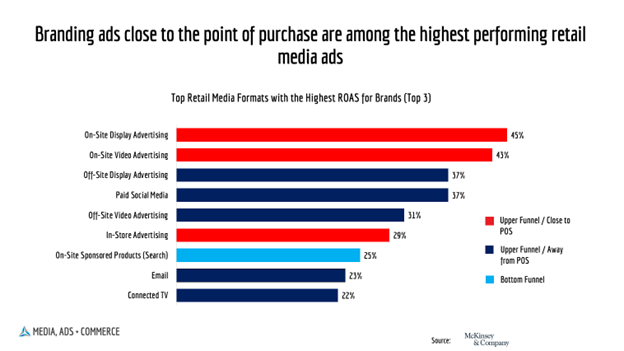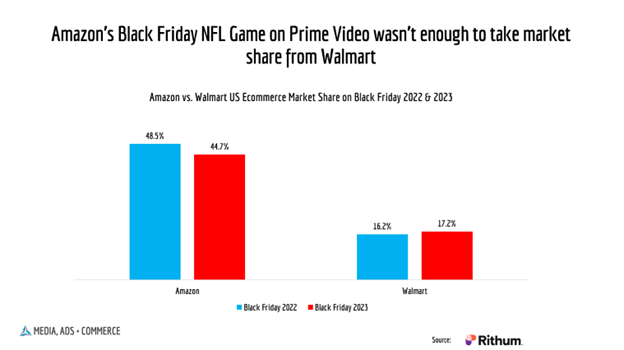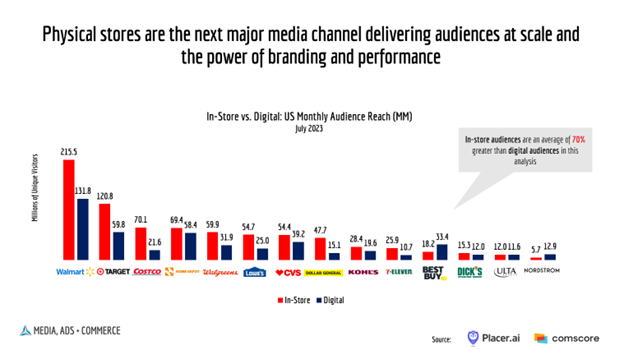Despite its categorization as a performance channel, retail media can be used to raise brand awareness. Here, retail expert Andrew Lipsman charts how ad formats usually seen as “upper-funnel” have been proven to also drive performance in the context of retail media. Strong creative delivered close to the point of purchase like on e-commerce websites can be effective at driving brand choice. And in-store audiences are just as responsive to brand messages as TV audiences, but are much closer to the point of purchase.
Although retail media is typically considered performance media, it’s much more than that. By residing at the intersection of the advertising industry’s three biggest dislocations – the decline of linear TV ratings, the deprecation of third-party cookies, and the digitization of physical stores – retail media provides brands with exactly what they need at this critical juncture.

With its foundation in closed-loop measurement, retail media can easily be overlooked for its ability to produce brand awareness and engagement at a massive scale – much like linear TV. And it can uniquely convert this branding impact into sales effectiveness at the same time, effectively delivering the holy grail for brands. This is evident across the three primary areas of retail media today: on-site, off-site, and in-store.
1. On-site display and video ads deliver the highest ROAS
Advertisers are discovering that ad formats generally considered “upper-funnel” are also the best at driving performance in the context of retail media, according to a 2023 survey by McKinsey & Company. The study found that the top-performing retail media ad formats were on-site display ads (45%) and on-site video ads (43%) – far outpacing the bottom-funnel on-site sponsored product placements (25%).

There are several likely explanations. Strong creative delivered close to the point of purchase – in this case on e-commerce websites – should be effective at driving brand choice. Display and video ads are also more cost-efficient, all else equal than sponsored product ads due to less active bidding from mid- and long-tail advertisers. This stands in contrast to connected TV, which may rate high on the effectiveness scale but struggles to deliver return on advertising spend (ROAS) given its high CPMs.
2. Retail media streaming TV brings measurability to “the least measurable medium”
Nevertheless, there is considerable promise in retail media’s streaming TV opportunity. Despite the ultimate branding medium traditionally being the least measurable, that’s changing fast. Brands can precisely target purchase-based audiences and close-the-loop on performance to online and in-store sales.
Amazon brought this capability to NFL Thursday Night Football during the 2023 season, putting targeted closed-loop measurement against highly-rated TV programming for the first time. Amazon took it a step further with the first-ever Black Friday NFL football game, an experiment that seemed perfect to keep holiday shoppers tethered to their couch and shopping online during a day known for hitting the stores. Advertisers for the event used shoppable ad formats designed to get people holiday shopping straight from their TV sets.
The only problem with this ambitious effort is that it didn’t produce any discernible gains for the e-commerce behemoth. In fact, according to data from Rithum, Amazon’s US e-commerce market share on Black Friday dipped from 48.5% in 2022 to 44.7% in 2023. Meanwhile, top competitor Walmart – better known as a Black Friday in-store destination – gained a full percentage point.

None of this means that streaming TV won’t be a performance channel, just that it will take time to figure things out. More advanced segmentation and improved offline attribution should help things along. But the true power of performance TV will unlock when viewers learn to lean forward into actions – like “add to cart” – during a lean-back experience.
3. In-store retail media ads deliver reach, quality, and performance
The digitization of physical stores is now bringing dynamic ads close to the point of purchase where 85% of retail sales still occur. While there’s an understandable tendency to evaluate in-store ads’ effect on driving in-store sales, it can ignore the medium’s potential for upper-funnel impact.
Top retailers boast massive audience reach that surpasses 50 or 100 million people, in some cases topping the broadcast TV networks. A July 2023 analysis of 13 leading brick-and-mortar retailers found their in-store audience reach was 70% higher on average than their digital audiences.

We don’t tend to think of “shoppers” as “audiences”, but that’s exactly what they should be for national brands who want to get in front of as many eyeballs as possible. Even better, those eyeballs can be reached in contextually relevant, brand-safe environments with proximity to the point of purchase.
Of course, in-store retail media also drives sales at the register. Hershey’s tested an Ice Breakers brand equity campaign running on Grocery TV at the checkout aisle in grocery stores across six states. The study found that this campaign drove an incremental sales lift of 13.7% for the advertised brand over a three-month period, while also producing a halo effect that drove a 5.9% sales lift for Ice Breakers Mints.
Retail media advertisers need to start moving up the funnel
Advertisers have so much to gain from retail media if they would only adopt a more holistic view of how it drives “performance.” Retail media is a full-funnel vehicle, as much about awareness and affinity as it is about activation. The advertisers who realize this and invest in upper-funnel formats will find they end up getting the best of both worlds: branding and performance.

